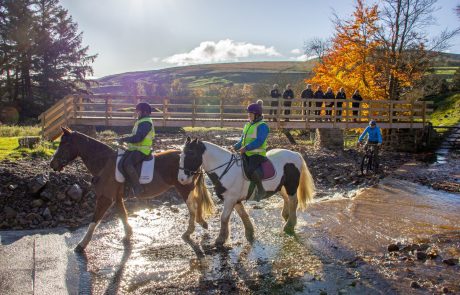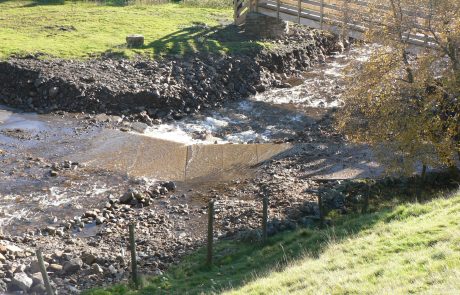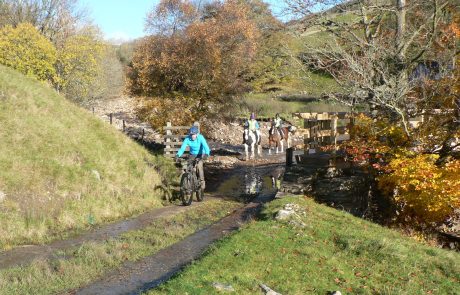News
Last link restored in flood hit northern dales
‘Last link’ restored in flood hit northern dales
13 December 2023
Rangers and volunteers with the Yorkshire Dales National Park have built a bridge over Slei Gill in Arkengarthdale, to complete a four-year programme of flood recovery work.
A total of 13 river crossings were swept away in Swaledale and Arkengarthdale following thunderstorms on 30 July 2019.
The bridge at Slei Gill, which is on the route of a popular bridleway in an area steeped in lead mining heritage, is the last significant piece of rights of way infrastructure to be put back.
The Tees-Swale: Naturally Connected programme, a joint venture funded by The National Lottery Heritage Fund and led by the North Pennines National Landscape and the Yorkshire Dales National Park Authority, paid for all the materials, which were sourced from Hartlington Fencing Supplies near Grassington.
In November those who had worked to restore the crossing met local horse riders and cyclists who tried out the new ford surface, constructed from precast concrete panels.
The job took six weeks for two rangers, who were assisted each day by Dales Volunteers.
Member Champion for Recreation Management at the Yorkshire Dales National Park Authority, Lizzie Bushby, said: “Through the Tees-Swale: Naturally Connected programme we have been able to improve six circular routes in this glorious part of the National Park. The Slei Gill bridge and ford make possible a circular walk or ride from Fremington and Reeth up to Langthwaite, where people can stop for refreshments at the Red Lion Inn, which itself was badly affected by the 2019 floods. It’s really satisfying that this last link has been restored. Sincere thanks are due to the 12 Dales Volunteers, including members of the Ragged Robin group, who worked on the bridge. Many hands made light work, especially when gathering stone from the beck to face the bridge abutments. Thanks also go to our contractors who lifted the concrete panels into place; the ford is now easier for riders to cross than it was before the floods. And the work simply wouldn’t have been possible without National Lottery players and the support of The National Lottery Heritage Fund.”
North Yorkshire Council delegates responsibility for rights of way maintenance in the Yorkshire Dales National Park to the National Park Authority. However the council has helped with repairs to the public rights of way network affected by the 2019 storm, including by replacing two 18-metre footbridges.
Notes for editors
Image: ‘Horse riders Jane Baker and Lucy Sterry from Arkle Moor Riding Centre and cyclist Stuart Price from Dales Bike Centre, with rangers and volunteers on the footbridge, enjoy the restored crossing at Slei Gill in Arkengarthdale’. Credit: Wendy McDonnell/YDNPA
For more information, please contact the Yorkshire Dales National Park Authority’s Media Officer, Andrew Fagg (Andrew.Fagg@yorkshiredales.org.uk), or Communications Manager, Mark Sadler (Mark.Sadler@yorkshiredales.org.uk).
About The National Lottery Heritage Fund
As the largest dedicated funder of the UK’s heritage, The National Lottery Heritage Fund’s vision is for heritage to be valued, cared for, and sustained for everyone, now and in the future as set out in our strategic plan, Heritage 2033.
Over the next ten years, we aim to invest £3.6billion raised for good causes by National Lottery players to bring about benefits foe people, places, and the natural environment.
We help protect, transform, and share the things from the past that people care about, from popular museums and historic places, our natural environment and fragile species, to the languages and cultural traditions that celebrate who we are.
We are passionate about heritage and committed to driving innovation and collaboration to make a positive difference to people’s lives today, while leaving a lasting legacy for future generations to enjoy.
Follow @HeritageFundUK on Twitter, Facebook and Instagram and use #NationalLotteryHeritageFund www.heritagefund.org.uk
The Yorkshire Dales National Park is one of 15 National Parks in the UK. It is administered by the Yorkshire Dales National Park Authority, which has two main purposes: “to conserve and enhance the natural beauty, wildlife and cultural heritage” and “to promote opportunities for the understanding and enjoyment of the special qualities of the National Park”. In carrying out these purposes, the Authority has a duty “to seek to foster the economic and social well-being of local communities”. The National Park Authority comprises 25 members, made up of county and district councillors and members appointed by the Secretary of State for the Environment to represent parishes or in recognition of their specialist skills or knowledge.
All of our work is guided by the vision for the future of the National Park set out in the Yorkshire Dales National Park Management Plan: “Through their passion for this special place, local people and businesses will keep the Yorkshire Dales National Park a thriving area. Its unique cultural landscape will be treasured for its stunning scenery, exceptional heritage and wonderful wildlife, and every year millions of people will be inspired to be a part of it.”
The North Pennines is one of England’s most special places – a peaceful, unspoilt landscape with a rich history and vibrant natural beauty. It was designated as an Area of Outstanding Natural Beauty (AONB) in 1988. The purpose of this nationally recognised designation is the conservation and enhancement of the natural beauty of the area. The AONBs were renamed National Landscapes in November 2023.
At almost 2,000 sq. kilometres the North Pennines is the second largest of the 46 National Landscapes (in England, Wales and Northern Ireland) and is one of the most peaceful and unspoilt places in England. Visit www.landscapesforlife.org.uk for information about the National Landscape family.
The North Pennines lies between the National Parks of the Lake District, the Yorkshire Dales, and Northumberland with the urban centres of County Durham away to the east. Parts of the National Landscape are within the boundaries of five local authorities; the three counties of Cumbria, Durham and Northumberland, Cumberland Council, and Westmorland and Furness Council.
The North Pennines National Landscape is an alliance of 24 public, statutory and voluntary sector bodies with an interest in the future of the North Pennines National Landscape. The work of the National Landscape is carried out by its staff unit which takes action to conserve and enhance the natural beauty of the area, to raise awareness of its special qualities and to improve the quality of life for local people.
UNESCO Global Geopark As well as being a National Landscape, the North Pennines is a UNESCO Global Geopark. This puts the area’s Geopark status in the same UNESCO family as World Heritage Sites and Biosphere Reserves. UNESCO Global Geoparks are places with outstanding geology where special effort is made to make the most of geological heritage to support community and economy. Locally this includes producing geo-trails, developing projects with school and community groups, producing displays for visitor attractions, and holding geology festivals and events.
The North Pennines National Landscape and the Yorkshire Dales National Park Authority are working with partner organisations to deliver Tees-Swale: Naturally Connected, a major natural heritage programme that focuses on the landscape and communities of Upper Teesdale and Swaledale, covering 829 square kilometres of Teesdale in the North Pennines National Landscape and Swaledale in the Yorkshire Dales National Park. Inspired by the report ‘Making Space for Nature’, the programme aims to restore, expand and connect habitats across the uplands of Teesdale and Swaledale, showcasing how public funds can enhance wildlife and deliver multiple public benefits. The ethos of the programme is to work closely and in partnership with farmers, landowners and conservation agencies from the outset. In so doing, we will build the relationships and establish the skills required to sustain our High Nature Value farming systems.
High Nature Value farming is a term used to describe low intensity farming systems that are particularly valuable for wildlife, the environment, and people. The concept of knowledge exchange will be a core principle of the programme, with farmers encouraged to share their land management skills and experience, in order to target habitat improvement and restoration, in a way that allows the whole farm to work as a system.
Through an innovative programme of interpretation, activities, and rights of way improvements, we will enable people to discover, explore and enjoy the stunning landscape of Teesdale and Swaledale. At the heart of this will be a drive to reveal to visitors how this landscape is managed and why this is relevant to them. Opportunities will include on-farm activities and community-led environmental art. A comprehensive learning programme will see skills developed through traineeships, knowledge-exchange schemes, and volunteering with the aim of building resilience within farming communities and empowering a future rural workforce.










